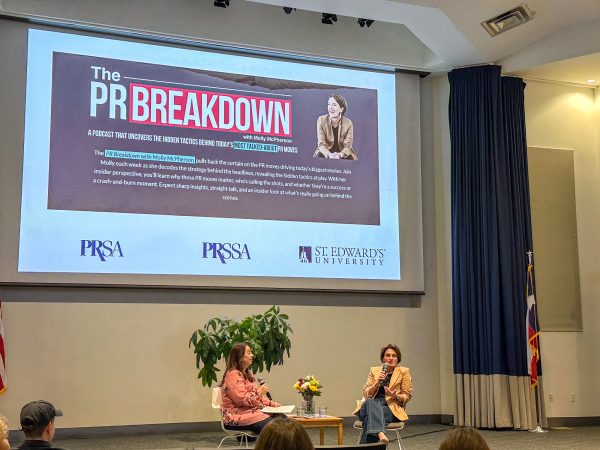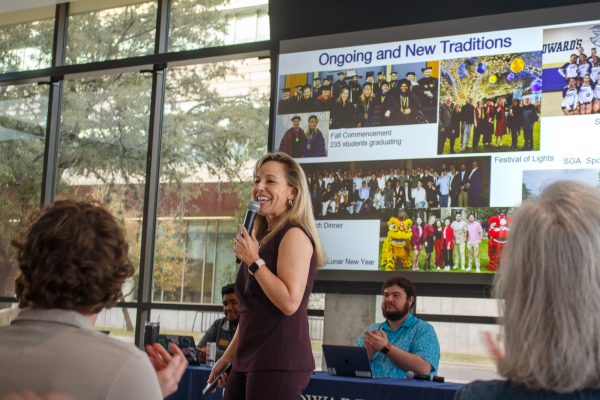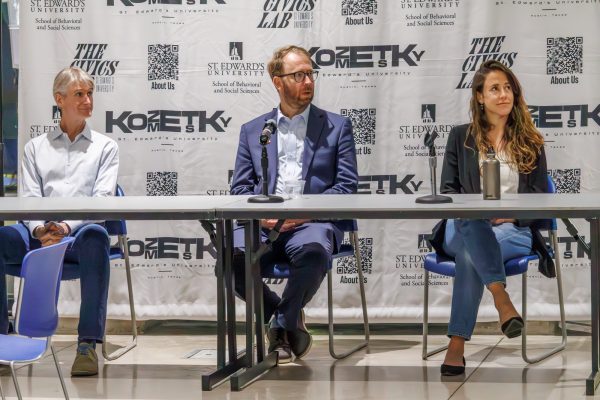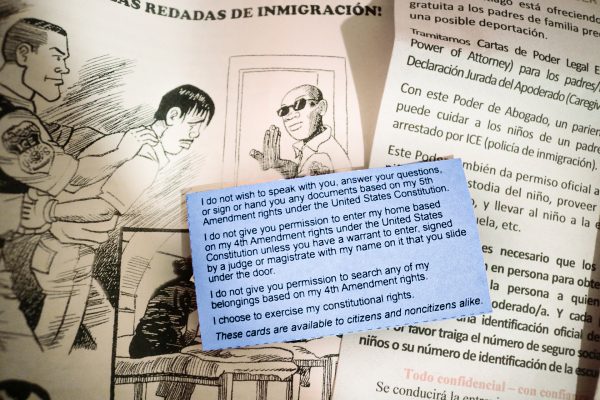President Martin addresses Pavilions, enrollment decrease
President George E. Martin delivered his “State of Our Campus” meeting Oct. 30 after a tumultuous week on campus that faced the effects of recent position eliminations at the university.
The event provided students with the opportunity to hear from Martin over the university’s outlook. Following Martin’s address, students were given the opportunity to speak to various faculty members from upper administration.
Student Government Association President Ben Griffith opened the evening in Carter Auditorium by applauding audience presence as a beneficial commitment to St. Edward’s.
“All of this information is really important,” Griffith said. “You all care about the university’s future.”
Martin began the presentation with statistics showcasing the university’s recent accomplishments; once more recognizing St. Edwards’s rank as 15 in the Western region according to the U.S. News and World Report. Highly acclaimed graduate school programs St. Edward’s students have gone on to attend made an appearance in the presentation; Universities listed included Yale, Brown, Cornell, Stanford and more.
Transitioning into the university’s recent, prevalent struggles, Martin noted retention and recruitment as some of the biggest issues.
He also wasted no time in addressing the Pavilion-sized elephant in the room, citing incompletion to increased labor shortages.
While projects like the operations building, the UFCU Alumni gym’s floor revamp, the Moreau Hall refresh and dining facility renovation proved successful, the overall gaping hole of several campus construction projects still leaves a notable deficit.
Mentioning the city-wide drawback of other building projects, Martin said that several projects around Austin have been pushed back as well—especially with restructure following Hurricane Harvey.
“Look at the Fairmont Hotel, a project that was supposed to be completed in September,” Martin said. “It’s actually going to get a lot worse going forward because of the terrible destruction of Harvey.”
The Strategic Plan for 2022 was then presented, with a brief reflection on challenges that higher education has faced in the past decade.
“We came through the worst decade and half in higher education,” Martin said. “The Great Recession in 2008, the stock market performance until very recently, 20 years of declining wages, a decline of the middle class, a change in demographics.”
Martin also cited other federal regulations that have hindered higher education, including Title IX, tuition caps and state regulations like campus carry.
National cost effects presented themselves through the advance of technology and ever-increasing competition in higher education.
“So, our world has fundamentally changed, but then to be successful, we must be aware, responsive in a timely way,” Martin said. “We must be creative and flexible, positive and proactive.”
After a year-long effort to gather input from across the university, a five-year plan has been put into effect to fulfill the university’s overall intention of creating “pathways” for its students.
“Pathways begin wherever you are,” Martin said. “You might decide to alter your pathway, and the university has to be ready.”
After honing on the main objective of the plan—Holy Cross, Student Experience, Institutional Transportation and Austin Connection— Martin presented the university’s master plan.
Martin led with the caveat of this year’s low enrollment and retention rates leading to an overall slow-rising progression in the next few years; indicating that the master plan looks to 2019 for a balanced budget for incoming students.
This revenue progression is projected to come from an increase of a new graduate program every six months, as well as more online classes beginning as early as next semester. Residential growth is also in the works, coming from a plan to use the property of the recently closed El Gallo restaurant.
To create more communication across campus, Martin also announced the implementation of a Staff Council for faculty to become active in voicing change on campus.
Following Martin’s address, an informal panel took place outside of Carter Auditorium accompanied by dinner and refreshments. Panelists included Vice President of Student Affairs Lisa Kirkpatrick, Vice President for Financial Affairs Kim Kvaal, Associate VP of Campus Safety Scott Burnotes, Director of Student Life Tom Sullivan, Director of the Health and Counseling Center Calvin Kelly and other administrators.






